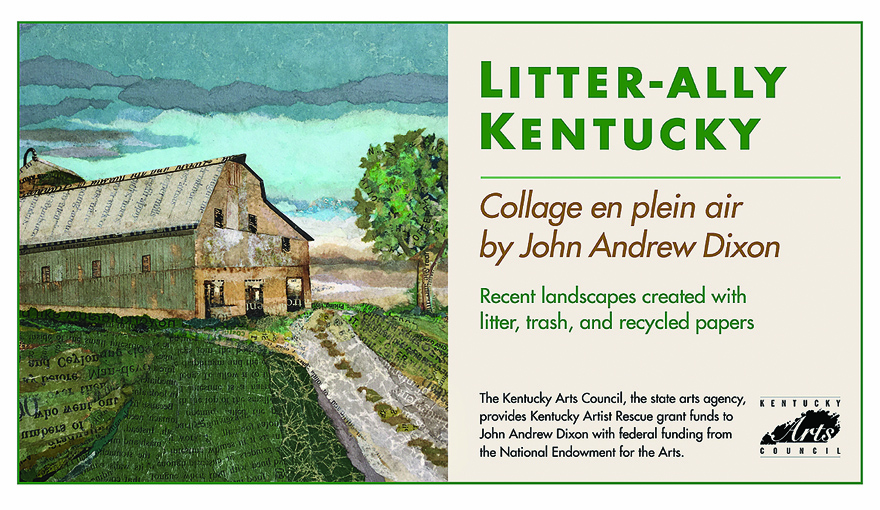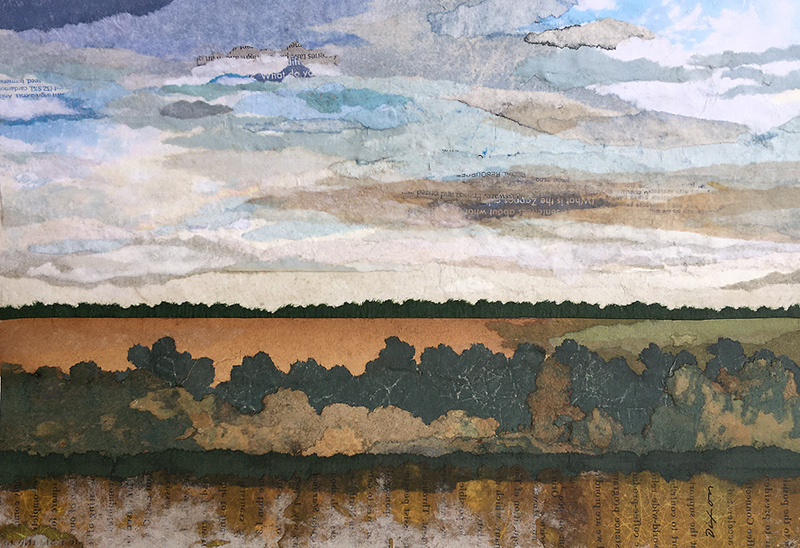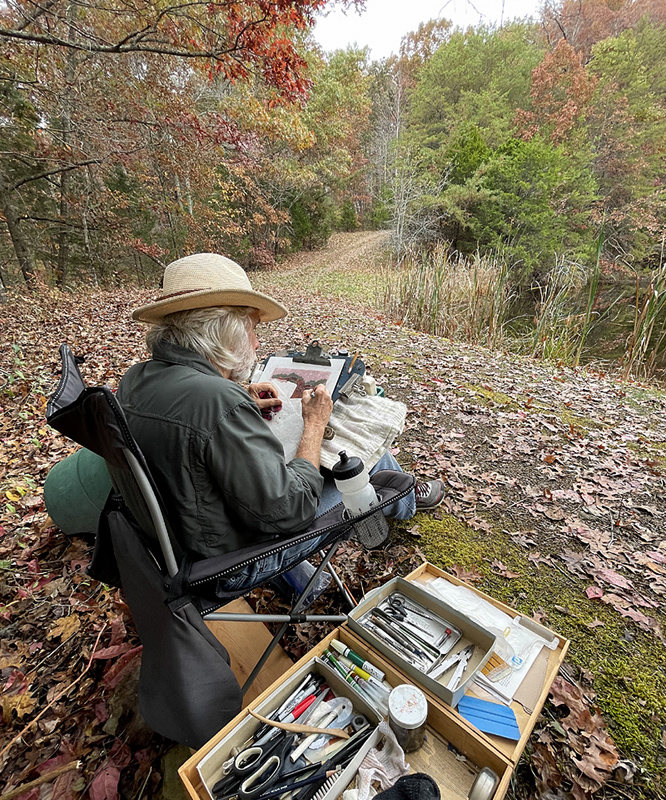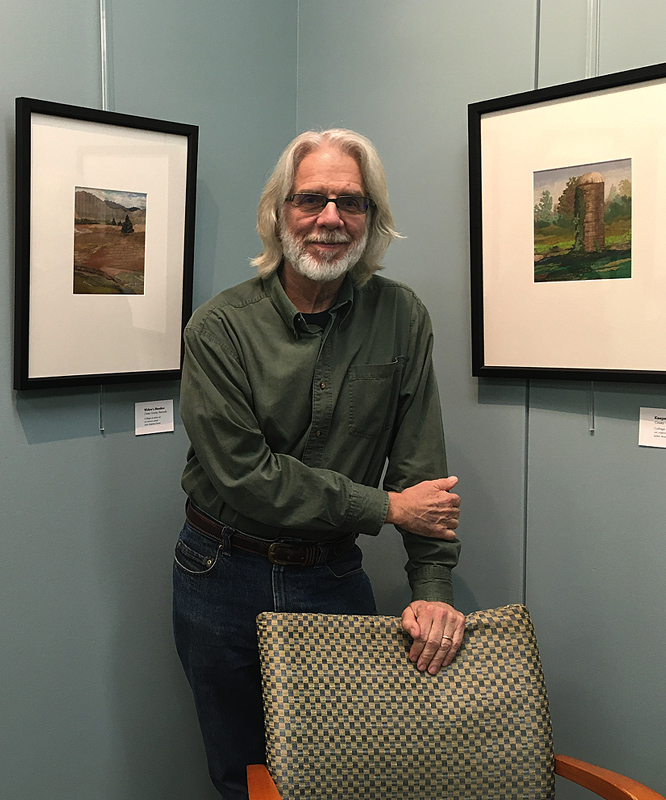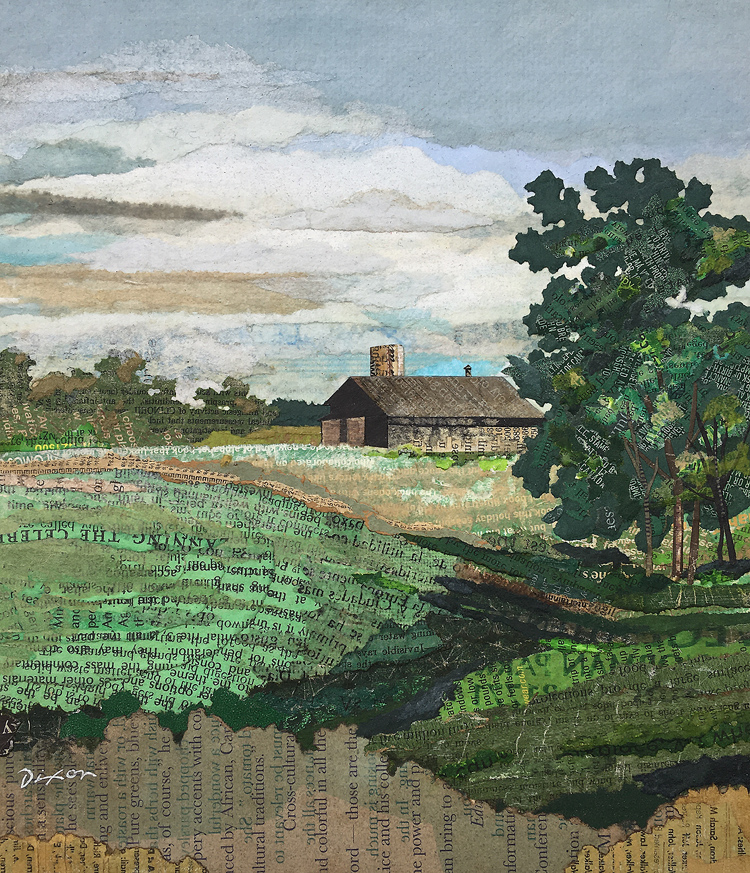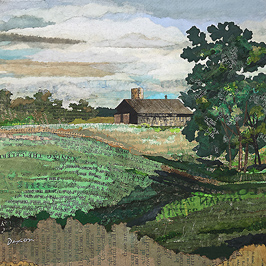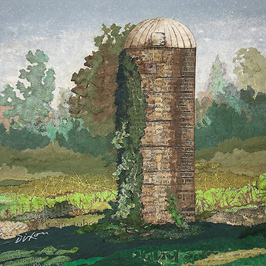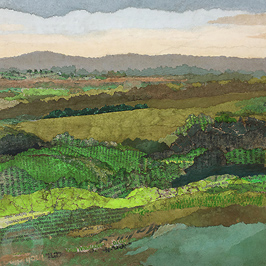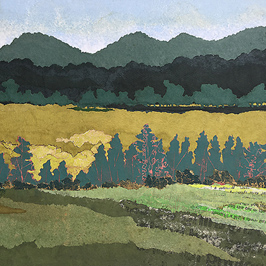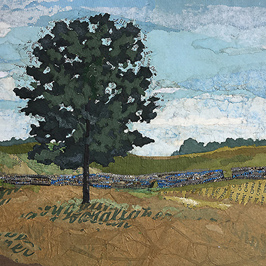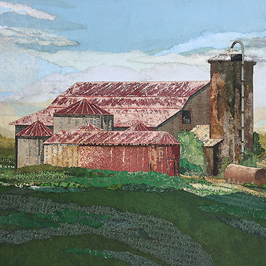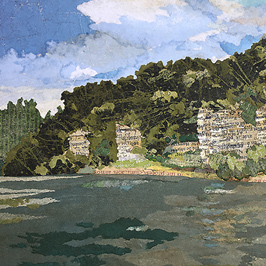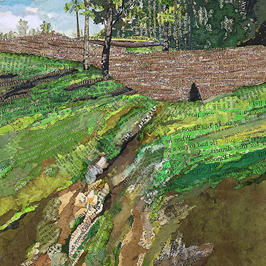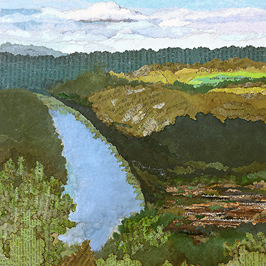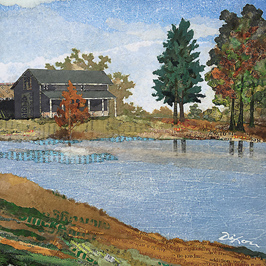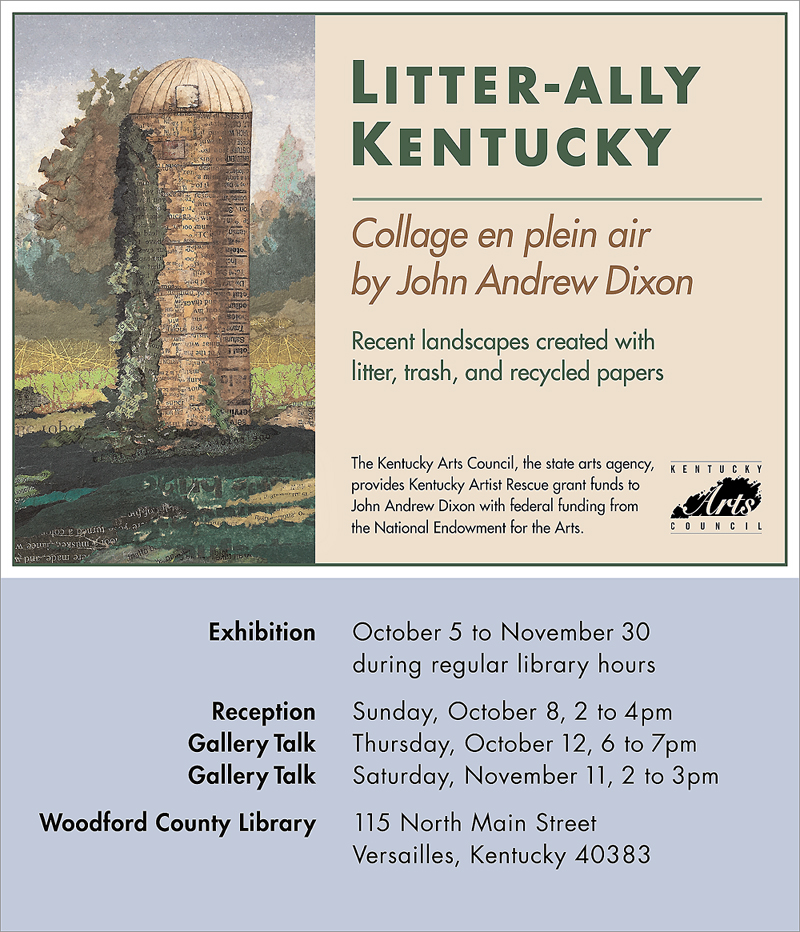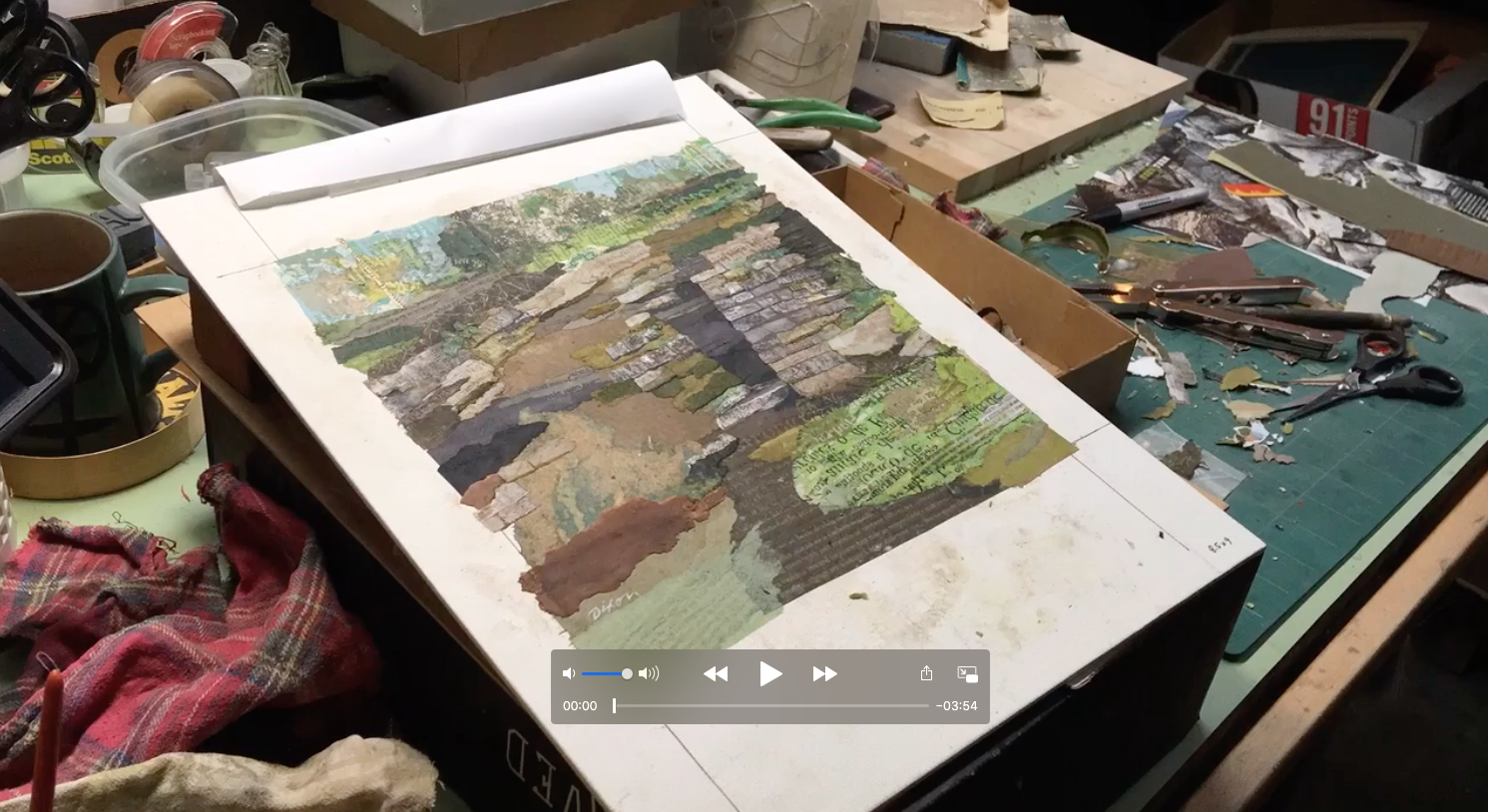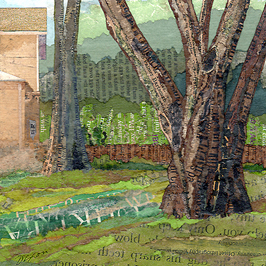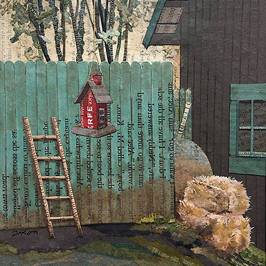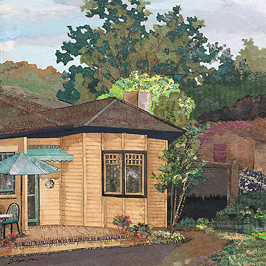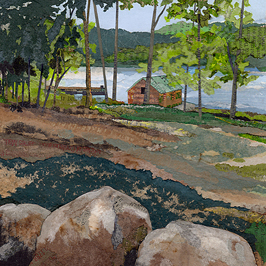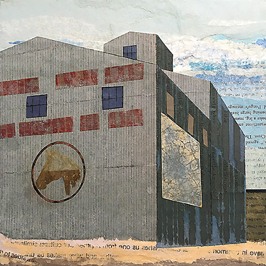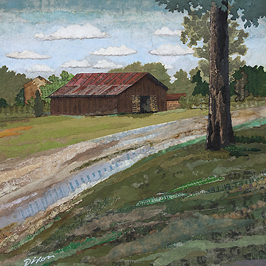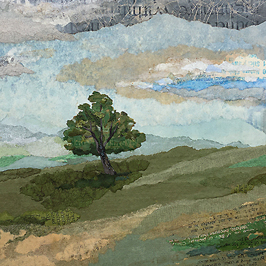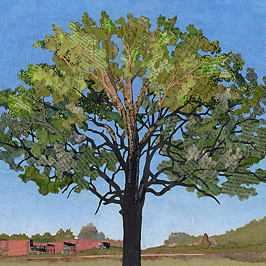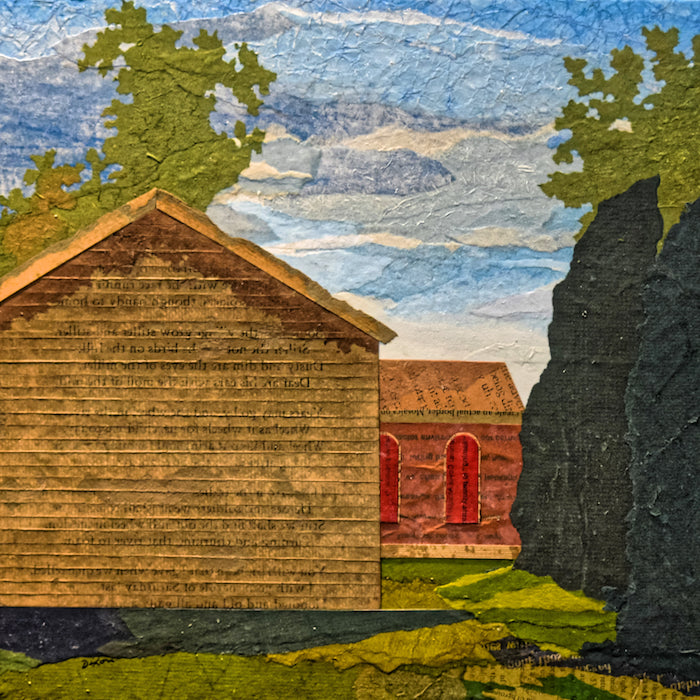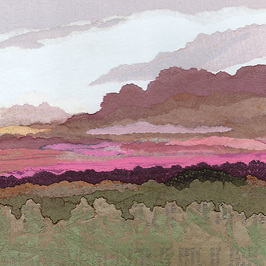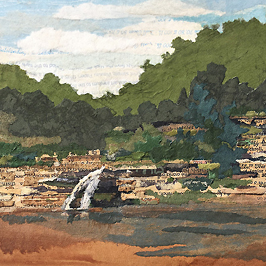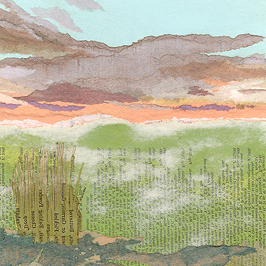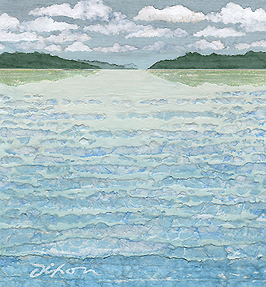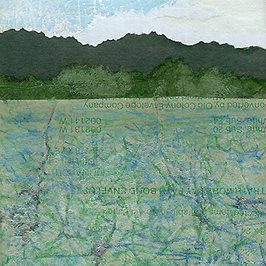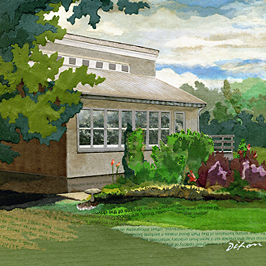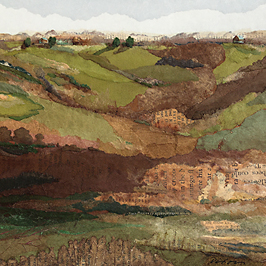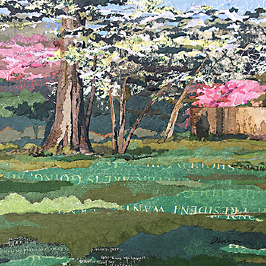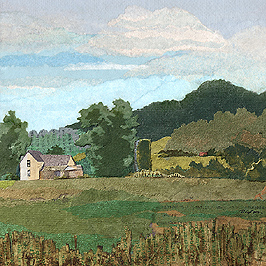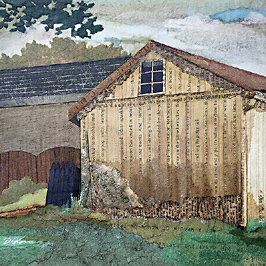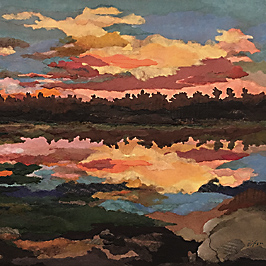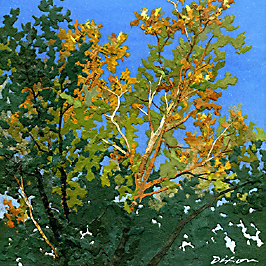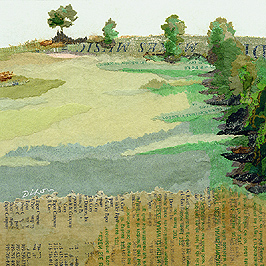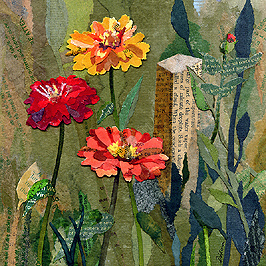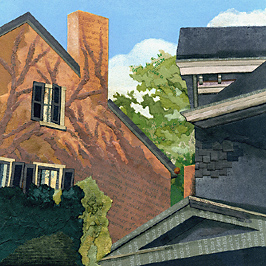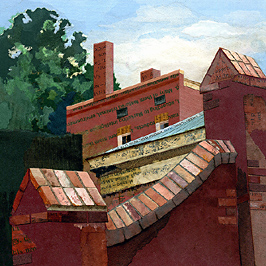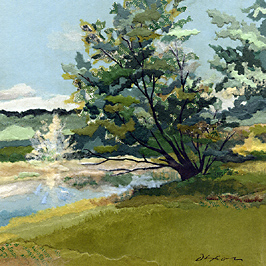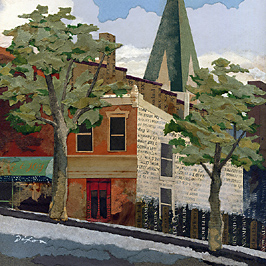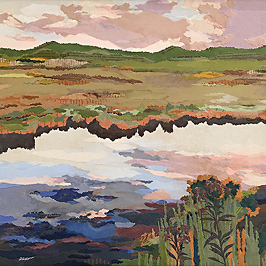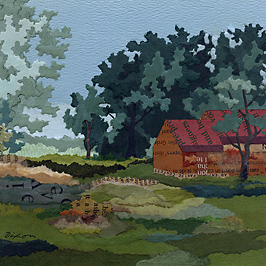My solo show of collage landscapes is back on display — this time at the Eastside Branch of the Lexington Public Library. The exhibition lasts from May 1 to June 30 — Palumbo Drive at Man O War Boulevard.
Archive for the ‘Landscape’ Category
Tiny PaperScape
Tuesday, April 30th, 2024This small paper landscape was created for an Art Center of the Bluegrass “tiny art” fundraiser, and if you know who selected it, please let her know that I will be more than happy to add a signature. Participants in this annual event are asked to submit the miniature piece unsigned. Click here for my guiding attitude about art donations.
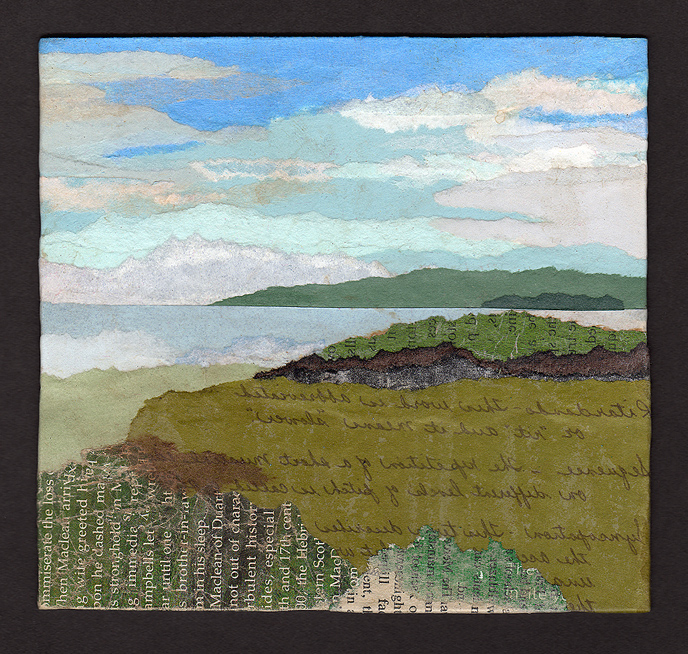
Tiny Paperscape
collage miniature by J A Dixon
6 x 6 inches
Capturing an Arcadian Sky
Monday, March 25th, 2024“I have learned to expect nothing of the weather
but what it gives us.”
— Rockwell Kent
Last September at nearby Arcadia Farm, I fell under the spell of a horizon and stuck with the mood of early-morning clouds for the rest of the session. With the prevailing heat, other members of the PAACK may have been praying for more breeze, but I was grateful for hours of no wind. I wasn’t even using clothespins! I wanted to interpret the viewscape as that huge land grant might’ve looked to the original Shelby family in the 1700s. Although pleased with the result that I took home, I knew I wanted to make studio additions at the base of the artwork before declaring it ready for a signature. And so here we are, March of 2024. As I look ahead to a new season of taking collage outside, it made sense to finally complete the studio refinements on one of my favorite landscapes from 2023.
Arcadian Sky
collage en plein air by J A Dixon
11.375 x 7.875 inches
available to collectors
Dreaming of Wind Harbor
Tuesday, February 27th, 2024“Nothing happens unless first we dream.”
— Carl Sandburg
Today’s featured artwork is a studio collage landscape inspired by a dream and finished from imagination. I believe it was triggered by a combination of time spent outside observing earth, sky, and water, with the natural reservoir of so-called talent cultivated from childhood.
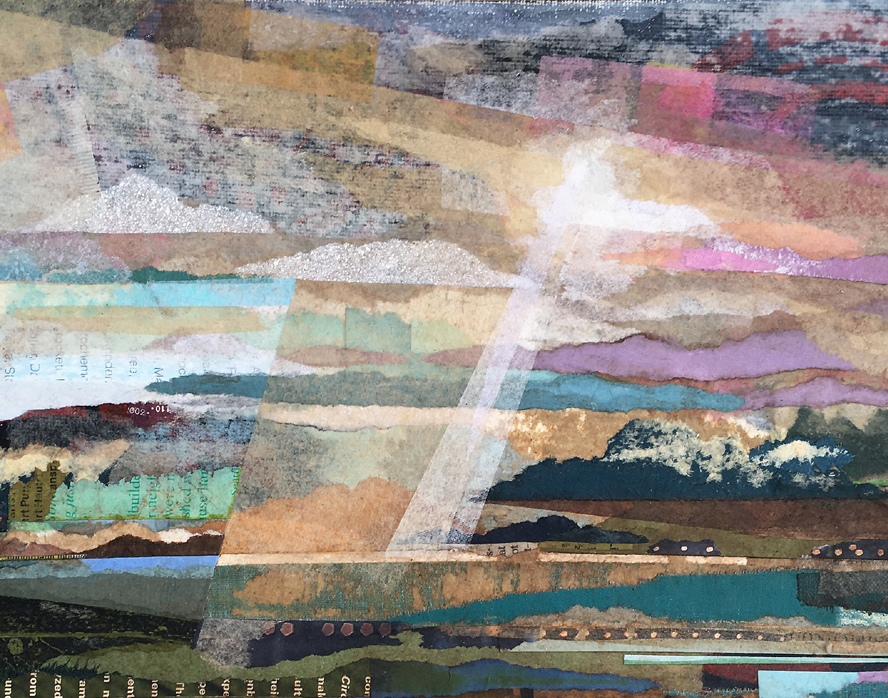 Dream-inspired images are rare creatures for me, but I grab one when it emerges. More often than not, my waking imagination falls short when trying to capture it. Over the years, I’ve had more success in that line coming up with graphic design concepts than I have with artistic impressions. It probably has something to do with how my subconscious responds to an explicit problem-solving setup, in contrast to more undefined visual images (which in my dreams tend to be preposterously complicated and nearly impossible to retain).
Dream-inspired images are rare creatures for me, but I grab one when it emerges. More often than not, my waking imagination falls short when trying to capture it. Over the years, I’ve had more success in that line coming up with graphic design concepts than I have with artistic impressions. It probably has something to do with how my subconscious responds to an explicit problem-solving setup, in contrast to more undefined visual images (which in my dreams tend to be preposterously complicated and nearly impossible to retain).
As happened when I shared this image elsewhere, I have often received the remark, “You’re so talented.” Many artists have heard this, too, and would relate to my mentioning it. I usually respond by saying something like this: talent alone goes stagnant early on if an individual doesn’t develop it with a life of effort and follow through. I appreciate what these people mean and their sincere intent to praise, 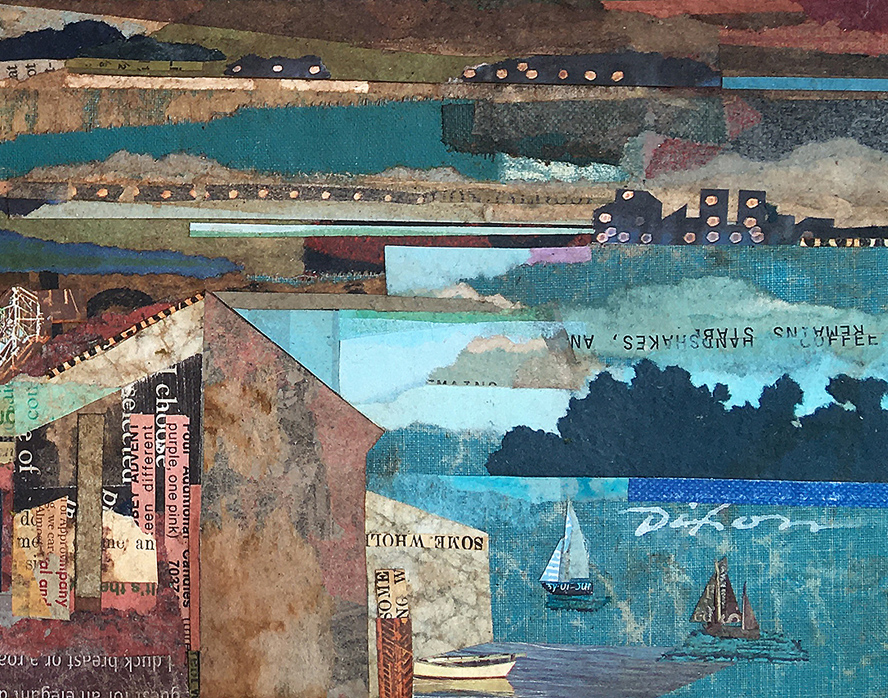 but they usually don’t grasp the full picture. A refined trust in intuition is often mistaken for talent, but actual talent is a creation of the Universal Source. Artistic talent, intellectual talent, empathic talent, athletic talent — there is no difference, because we all get our start with some kind of talent as a divine inheritance. For some of us, it might’ve been more obvious (especially if we liked to show off for others). How many “talented” young athletes are age-group champions into later life? How many “talented” young musicians or dancers become professional performers with the respect of their peers? There you have it. Any talent can be lost without the effort and stick-to-it mindset that overcomes challenges and builds effective skills and attitudes. And make no mistake about it — such acquired discipline comes from God, too, so let’s give proper credit and keep working!
but they usually don’t grasp the full picture. A refined trust in intuition is often mistaken for talent, but actual talent is a creation of the Universal Source. Artistic talent, intellectual talent, empathic talent, athletic talent — there is no difference, because we all get our start with some kind of talent as a divine inheritance. For some of us, it might’ve been more obvious (especially if we liked to show off for others). How many “talented” young athletes are age-group champions into later life? How many “talented” young musicians or dancers become professional performers with the respect of their peers? There you have it. Any talent can be lost without the effort and stick-to-it mindset that overcomes challenges and builds effective skills and attitudes. And make no mistake about it — such acquired discipline comes from God, too, so let’s give proper credit and keep working!
Wind Harbor
collage on canvas panel by J A Dixon
studio landscape from dream / imagination
14 x 11 inches
• S O L D
Believing is seeing . . .
Tuesday, November 21st, 2023“Accepting the familiar is the enemy of seeing… Seeing takes work and patience and concentration and focus otherwise we are always walking around in a fog only seeing what we think we know but not actually seeing anything at all.”
— Cecil Touchon
Although I have worked outside at entirely wild places (river palisades, for example), I seem to be drawn more to locations that have been cared for by others. To truly observe a rural setting and interpret it with found paper as a collage landscape, I need to spend hours slowing down my busy mind. I approach a kind of reverence for it as a place of evident stewardship and quiet beauty. It’s a slow-motion form of rapt attention, and I am able to see it as a fusion of natural creation with human affection. LITTER-ALLY KENTUCKY is the result.
Her Brother’s Barn
Boyle County, Kentucky
collage en plein air by J A Dixon
8 x 9.3125 inches
16 x 20 inches, framed
giclée print available
Now offering collector-quality glicée prints
Friday, November 10th, 2023The LITTER-ALLY KENTUCKY collection was conceived and funded as a traveling exhibition. While the original body of work is not currently for sale, all sixteen collage landscape artworks are available as affordable frame-worthy glicée reproductions printed on archival stock.
 Despite patrons’ asking for them over the years, offering prints is a first for me — other than at note card size. The high standards I was looking for have been met by Fine Art Editions Gallery & Press of Georgetown, Kentucky. Owner John S Hockensmith, well-known photographic artist who fine-tuned an advanced giclée process for his own exacting requirements, has made his exceptional quality available for my work. I’m gratified to be one of a limited number of Kentucky artists with whom he has chosen to collaborate.
Despite patrons’ asking for them over the years, offering prints is a first for me — other than at note card size. The high standards I was looking for have been met by Fine Art Editions Gallery & Press of Georgetown, Kentucky. Owner John S Hockensmith, well-known photographic artist who fine-tuned an advanced giclée process for his own exacting requirements, has made his exceptional quality available for my work. I’m gratified to be one of a limited number of Kentucky artists with whom he has chosen to collaborate.
 Due to the nature of the ingredients and constraints of working en plein air, my originals are typically small. Without loss of detail, these glicée enlargements capture the dimensionality of my collage technique and reveal subtleties of pasted layers and torn text. You can purchase individual prints at 150% enlargement on standard acid-free vellum stock for $275. The entire LITTER-ALLY KENTUCKY group of artworks can be acquired as a collector set printed on Japanese paper and housed in an archival box for $3500; individual works printed on the same handmade paper are available for $295 each.
Due to the nature of the ingredients and constraints of working en plein air, my originals are typically small. Without loss of detail, these glicée enlargements capture the dimensionality of my collage technique and reveal subtleties of pasted layers and torn text. You can purchase individual prints at 150% enlargement on standard acid-free vellum stock for $275. The entire LITTER-ALLY KENTUCKY group of artworks can be acquired as a collector set printed on Japanese paper and housed in an archival box for $3500; individual works printed on the same handmade paper are available for $295 each.
the LITTER-ally KENTUCKY collection
Monday, October 16th, 2023Thank you for your interest in this collection of plein air landscapes. The original collage artwork is infused with litter to encourage stewardship of natural places. Premium giclée prints are available here.
My solo landscape show: “LITTER-ALLY KENTUCKY”
Sunday, September 24th, 2023“At some point, the virtuosic construction of these works seems to fade in the mind, leaving in its wake only the images themselves: soft, somber, complicated skies worthy of Turner or Constable; rolling fields that would have attracted Thomas Hart Benton or Grant Wood.”
— Kevin Nance
A year after an update here about progress on my grant-supported body of new collage landscapes, I’m pleased to announce that this en plein air artwork will be revealed next month.
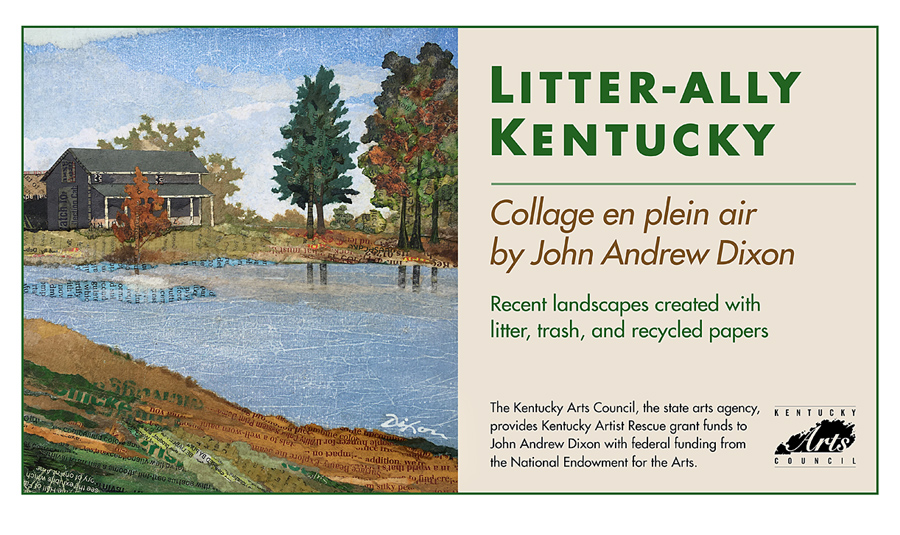
The exhibition will open on October 5 at the Woodford County Library in downtown Versailles, Kentucky, and continue through November during regular hours. The library will host an opening reception on Sunday, October 8, from 2pm until 4pm. I’ll give a gallery talk Thursday, October 12, at 6pm, and again on Saturday, November 11, at 2pm.
I’ve devoted much creative time and energy to this project over many months. Public funds have provided support and enabled me to bring a higher level of presentation to the most in-depth investigation that I’ve made into representational collage, 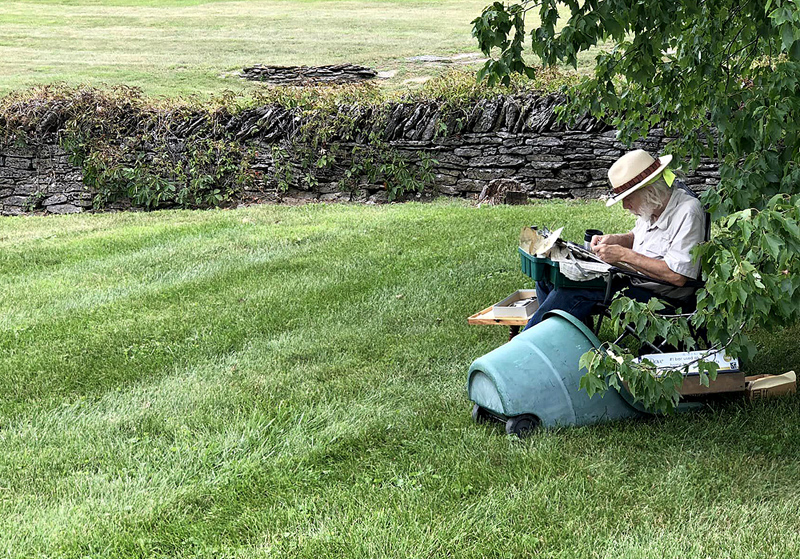 but the endeavor could not have been possible without the hospitality of those who opened their rural places to my grateful scrutiny. Fortunately, only one person declined to grant permission for me to “paint in papers.” Everyone else was astonishingly trusting and helpful. Of course, they know who they are, and I can’t thank them enough.
but the endeavor could not have been possible without the hospitality of those who opened their rural places to my grateful scrutiny. Fortunately, only one person declined to grant permission for me to “paint in papers.” Everyone else was astonishingly trusting and helpful. Of course, they know who they are, and I can’t thank them enough.
The artworks that I created at locations in six Central Kentucky counties are infused with fragments of litter accumulated along local streets and roadways. The concept of using collage art to bring awareness to the ongoing problem of littering was the theme of my application for support during the aftermath of lockdowns. I received a Kentucky Artist Rescue grant from the Kentucky Arts Council with federal funding from the National Endowment for the Arts.
Since I intend to have this show travel around a bit over the coming months, I want to acknowledge the individuals in Woodford County who offered my first opportunity: Karen Kasacavage and Tommy Dennison.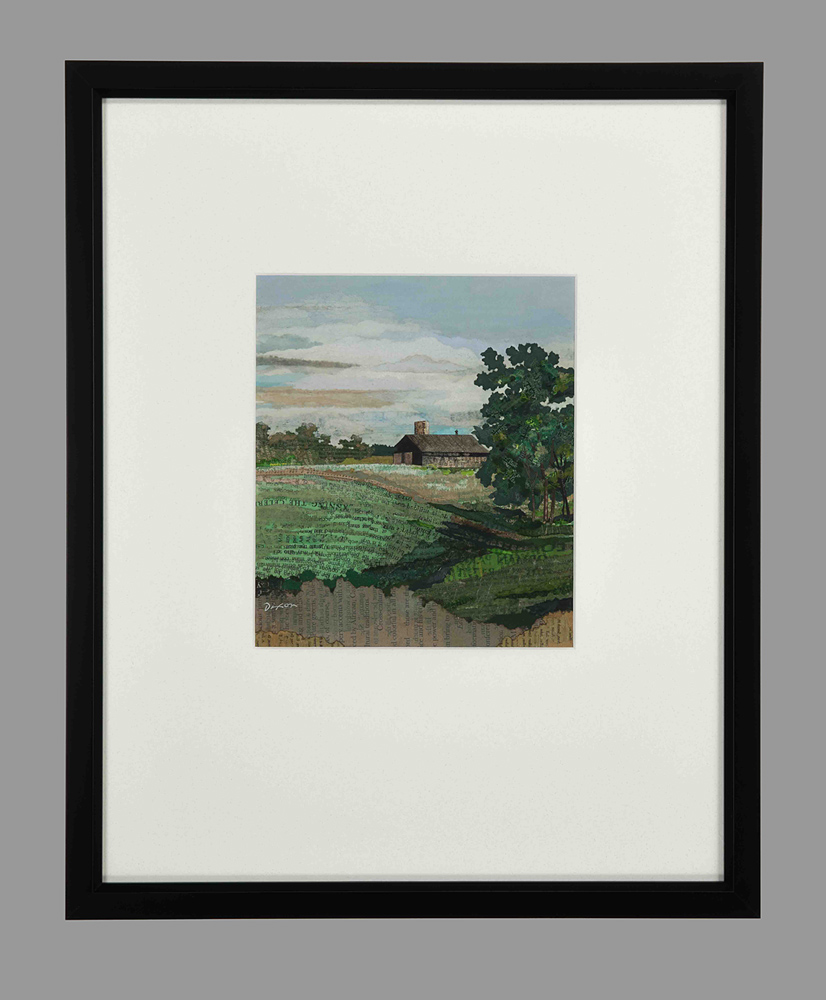 Leave it to a pair of helpful librarians to get me out of the starting gate! Because part of my overall effort is to engage both children and adults during the show’s run, this will be an ideal setting to carry an unconventional message about achieving a cleaner environment in the Commonwealth. With this recent body of work, I’ve repurposed the products of our “toss-it” culture as interpretations of specific natural places. My hope is to bring awareness to the role of individuals in reducing consumer waste and to promote a more conscious stewardship of the land that surrounds us.
Leave it to a pair of helpful librarians to get me out of the starting gate! Because part of my overall effort is to engage both children and adults during the show’s run, this will be an ideal setting to carry an unconventional message about achieving a cleaner environment in the Commonwealth. With this recent body of work, I’ve repurposed the products of our “toss-it” culture as interpretations of specific natural places. My hope is to bring awareness to the role of individuals in reducing consumer waste and to promote a more conscious stewardship of the land that surrounds us.
Each of the 16 artworks (ten verticals and six horizontals) is matted and framed in the “gallery style” within a 16×20-inch proportion. In order to allow a series of showings in different counties, the originals will not be available for purchase at this time. Instead, collector-quality glicée prints of all the landscapes on display will be offered through Fine Art Editions of Georgetown, Kentucky. You are invited to visit the exhibition and attend associated events. I also will have original collage artwork for sale across the street from the library at Art Space Versailles.
As LITTER-ALLY makes its journey around Kentucky, stop back here for more information, new developments, and to dig a bit deeper into my adventure creating collage landscapes en plein air.
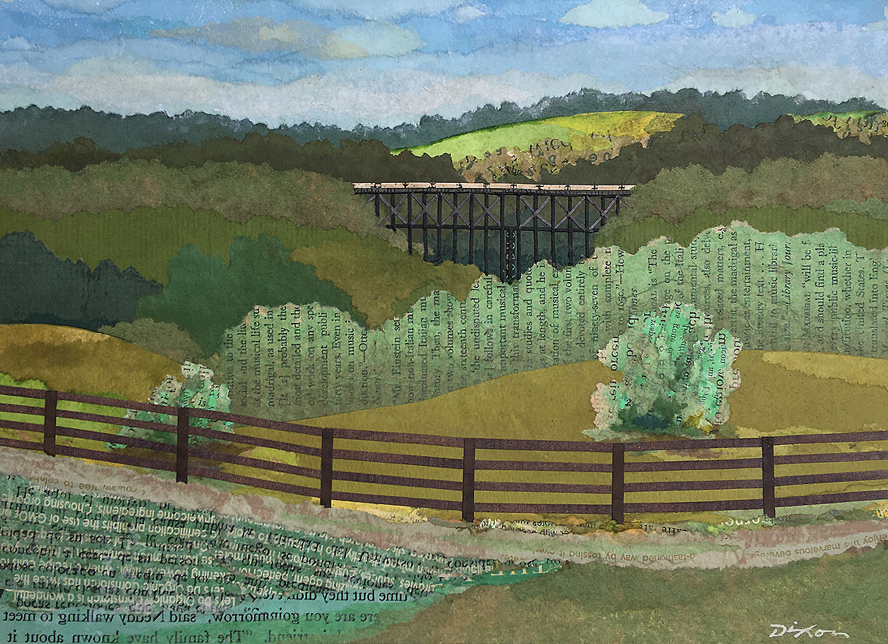
High Bridge Vantage
Garrard County, Kentucky
collage en plein air by J A Dixon
10.9375 x 7.9375 inches
20 x 16 inches, framed
giclée print available
Finishing Touches
Friday, September 1st, 2023First Gallery of Collage Landscapes
Wednesday, March 8th, 2023Thanks for your interest in my collage landscapes. Click on each thumbnail to view a larger image. Click here to scroll the original blog posts. My previously sold CHANGE OF SEEN artworks can be ordered as prints.
View the LITTER-ally KENTUCKY collection, too!
